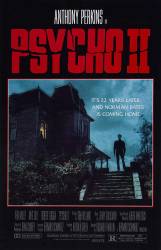Audio problem: When Norman is talking to his "Mother" on the phone, the camera (in Mary's point-of-view) comes in the room and Norman says, "How could you think such a thing. I would never do such a thing," but you can see Norman's reflection in the big mirror hanging in the lounge room and you can see his mouth isn't moving. (01:33:00)

Psycho II (1983)
1 audio problem - chronological order
Directed by: Richard Franklin
Starring: Robert Loggia, Anthony Perkins, Vera Miles, Meg Tilly
Continuity mistake: After Norman argues with Mr Toomey, before he goes up to the house, you can plainly see the light on in the living room where Mary is sitting. When Norman goes in the house, Mary is sitting in the dark and Norman then turns on the light.
Norman Bates: I don't kill people anymore.
Trivia: The reflection of young Norman Bates in the doorknob when he flashes back to his mother's poisoning is Anthony Perkins' son, Oz.
Join the mailing list
Separate from membership, this is to get updates about mistakes in recent releases. Addresses are not passed on to any third party, and are used solely for direct communication from this site. You can unsubscribe at any time.
Check out the mistake & trivia books, on Kindle and in paperback.




Chosen answer: The murderer is Emma Spool, Norman's biological mother. She was killing people because she didn't want anybody harming Norman.
Emma was not Norman's biological mother. She was the sister of Norma (and Norman's aunt) and jealous that Mr. Bates chose Norma over her and thought Norman should have been the son she and Mr. Bates were suppose to have. Later, while still mentally ill, she believed Norman was her son and told Norman this.
Bishop73
Emma Spool was, in fact, Norman's biological mother. It was revealed at the end of the movie that she is his real mother and Norma Bates is her sister who adopted Norman and raised him While Emma was institutionalized.
ctown28 ★
Again, that was just Emma being delusional and/or lying. Tracy Venable tells Norman the truth in Psycho III. Emma was never his mother.
Bishop73
I never knew Emma Spool was Norman's biological mother. In fact, I never heard of Emma Spool. Thanks.